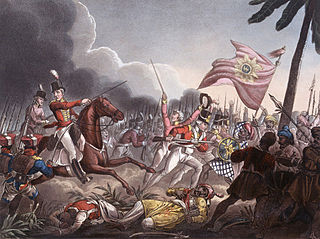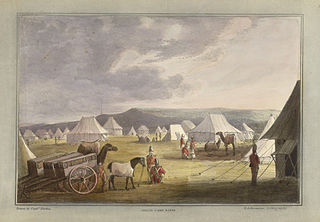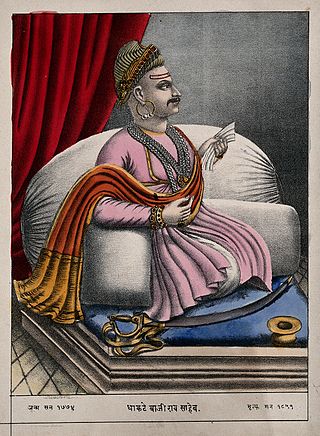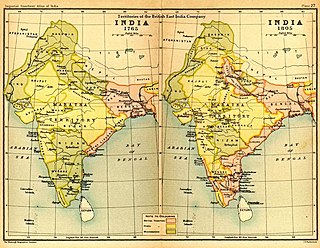Related Research Articles

The Maratha Empire, also referred to as the Maratha Confederacy, was an early modern Indian confederation that rose to dominate much of the Indian subcontinent in the 18th century. Maratha rule formally began in 1674 with the coronation of Shivaji of the Bhonsle dynasty as the Chhatrapati. Although Shivaji came from the Maratha caste, the Maratha empire also included warriors, administrators and other notables from Maratha and several other castes from Maharashtra.

The Second Anglo-Maratha War (1803–1805) was the second conflict between the British East India Company and the Maratha Empire in India.

The Third Anglo-Maratha War (1817–1819) was the final and decisive conflict between the English East India Company and the Maratha Empire in India. The war left the Company in control of most of India. It began with an invasion of Maratha territory by British East India Company troops, and although the British were outnumbered, the Maratha army was decimated. The troops were led by Governor General Hastings, supported by a force under General Thomas Hislop. Operations began against the Pindaris, a band of Muslim mercenaries and Marathas from central India.

Balaji Bajirao, often referred to as Nana Saheb I, was the 8th Peshwa of the Maratha Confederacy in India. He was appointed as Peshwa in 1740 upon the death of his illustrious father, the Peshwa Bajirao I.

The Holkars were a dynasty of Maratha Confederacy of India. The Holkars were generals under Peshwa Baji Rao I, and later became Maharajas of Indore in Central India as an independent member of the Maratha Empire until 1818. Later, their kingdom became a princely state under the protectorate of British India.

The First Anglo-Maratha War (1775–1782) was the first of three Anglo-Maratha Wars fought between the British East India Company and Maratha Empire in India. The war began with the Treaty of Surat and ended with the Treaty of Salbai. The war was fought in between Surat and Pune Kingdom saw British defeat and restoration of positions of both the parties before the war. Warren Hastings, the first President and Governor-General of East India Company's provinces in India decided not to attack Poona directly.

Vasai is a historical place and City near Mumbai's western suburbs, located in Palghar district which was partitioned from the Thane district in 2014. It also forms a part of Vasai-Virar twin cities in the Konkan division of Maharashtra, India.

Shrimant Peshwa Baji Rao II was the 13th and the last Peshwa of the Maratha Empire. He governed from 1795 to 1818. He was installed as a puppet ruler by the Maratha nobles, whose growing power prompted him to flee his capital Poona and sign the Treaty of Bassein (1802) with the British. This resulted in the Second Anglo-Maratha War (1803–1805), in which the British emerged victorious and re-installed him as the titular Peshwa. In 1817, Baji Rao II joined the Third Anglo-Maratha War against the British, after they favoured the Gaekwad nobles in a revenue-sharing dispute. After suffering several battle defeats, the Peshwa surrendered to the British, and agreed to retire in return for an estate at Bithoor and an annual pension.

Fort Vasai is a ruined fort of the town of Vasai (Bassein), Maharashtra, India. The structure was formally christened as the Fort of St. Sebastian in the Indo-Portuguese era. The fort is a monument of national importance and is protected by the Archaeological Survey of India.

Nana Fadnavis, born Balaji Janardan Bhanu, was an influential minister and statesman of the Maratha Empire during the Peshwa administration in Pune, India. James Grant Duff states that he was called "the Maratha Machiavelli" by the Europeans.

Raghunathrao Bhat also known as Ragho Ballal or Ragho Bharari was the 11th Peshwa of the Maratha Empire for a brief period from 1773 to 1774. He was known among the Hindus for his extremely successful North-western campaign of 1757-58 and for his works to liberate the Hindu holy places of Kashi and Ayodhya.

The Treaty of Bassein was a pact between the English East India Company and Baji Rao II, the Maratha confederacy's Peshwa, it was signed on 31 December 1802 after the Battle of Poona, at the present day Bassein (Vasai). The treaty was a decisive step in the dissolution of the Maratha Empire, which led to the East India Company's annexation of the empire's territories in western India in 1818.

The Maratha Conquests were a series of conquests in the Indian subcontinent which led to the building of the Maratha Empire. These conquests were started by Shivaji in 1659, from the victory at the Battle of Pratapgad against Bijapur. The expansion of the empire was limited and interrupted by the Mughal conquests of south India by Mughal emperor Aurangzeb. Marathas were forced to defend their territories against the overwhelmingly strong Mughal army in the 27 years long Deccan wars. They were able to defend their territories and gain an upper hand over Mughals in the sustained conflict.
The Treaty of Salbai was signed on 17 May 1782, by representatives of the Maratha Empire and the British East India Company after long negotiations to settle the outcome of the First Anglo-Maratha War it was signed between Warren Hastings and Mahadaji Sindhia. Under its terms, the Company retained control of Salsette and Broach and acquired guarantees that the Marathas would defeat Hyder Ali of Mysore and retake territories in the Carnatic. The Marathas also guaranteed that the French would be prohibited from establishing settlements on their territories. In return, the British agreed to pension off their protégé, Raghunath Rao, and acknowledge Madhavrao II as peshwa of the Maratha Empire. The British also recognised the territorial claims of the Mahadji Shinde west of the Jumna River and all the territories occupied by the British after the Treaty of Purandar were given back to the Marathas.
The Battle of Pune took place on 25 October 1802 near Pune between the rival factions of the Maratha empire. The forces of the Scindia (Shinde) and the Peshwa Bajirao II were attacked by the Holkars. While the British East India Company was not involved in the battle, its outcome and aftermath led to the Second Anglo-Maratha War.

Yashwant Rao Holkar also known as Jaswantrao Holkar belonging to the Holkar dynasty of the Maratha Empire was the Maharaja of the Maratha Empire. He was a gifted military leader and educated in accountancy as well as literate in Persian and Marathi and Urdu.
The Treaty of Surat was a treaty by which Raghunathrao, one of the claimants to the throne of the Peshwa, agreed to cede Salsette and Bassein Fort to the English, in consideration of being himself restored to Poona. The military operations that followed are known as the First Anglo-Maratha War. Warren Hastings, who in his capacity of Governor General claimed a right of control over the decisions of the Bombay Government, annulled the Treaty of Surat and sent his own agent to negotiate a very different new pact, the Treaty of Purandhar (1776).by the surath treaty ragoji was asked help to Britishers for ragoji become king of marata.
Baloji Kunjar / Kunjir (17??–1816) was Sardar and Minister of Affairs in service of Peshwa Baji Rao II. He was Peshwa Baji Rao II's favorite. After the death of Peshwa Sawai Madhavrao, there was debates for the position of Peshwa among the Maratha Empire. Balaji Kunjar performed a successful role to convey most friendly declaration and assurance between Baji Rao II and Nana Phadanvis, to appoint Baji Rao II as peshwa of Maratha Empire. Peshwa Baji Rao II and Nana Phadanvis awarded inam (Jagir) to him in 14 villages near Purandhar fort, for his role. He performed successful role in administration of maratha empire and as affairs minister or diplomat (vakil) for Peshwa Baji Rao II. He along with his son Pandoji Kunjar and Narayan, enjoyed the position as Sur-Patil (सर-पाटील) at Pune Punch Mahals during the era of Peshawa Baji Rao II. He along with his family has long enjoyed the privileges of sar-patil of 360 villages and towns in the Subha of Poona.
Amrut Rao was a Maratha noble, and the adopted son of Peshwa Raghunath Rao. In 1803, Yashwant Rao Holkar invaded Pune and deposed his adoptive brother Peshwa Baji Rao II. Subsequently, Holkar set up an ad hoc council nominally headed by Amrut Rao, and ran the Peshwa's government in his name. Holkar also installed Amrut Rao's son Vinayak Rao as the Peshwa to strengthen the legal status of his government, because Vinayak had been adopted by the widow of the deceased Peshwa Madhav Rao II. However, Baji Rao sought assistance from the British East India Company, whose advance forced Amrut Rao and his son to flee Pune. Subsequently, Amrut Rao signed a treaty with the British, agreeing to give up all claims over the Peshwa's office in return for a pension and an estate in Bundelkhand.

The Battle of Wadgaon was a battle fought between the Maratha Empire and the British East India Company near Vadgaon Maval village in Maharashtra and was part of the First Anglo-Maratha War.
References
- ↑ Encyclopædia Britannica - Treaty of Purandhar After the death of the peshwa Narayan Rao in 1773, his uncle Raghunath Rao tried to secure the succession.Raghunath's claim in the Treaty of Surat (7 March 1775) in return for Salsette Island and Bassein (Vasai). But the supreme government disallowed this treaty and sent its own agent to renegotiate. The resulting Treaty of Purandhar annulled that of Surat. Raghunath was pensioned and his cause abandoned, but Salsette and the Broach revenues were retained by the British. The tangle was increased by the support of the London authorities for Bombay, which in 1778–79 again supported Raghunath. Peace was finally restored in 1782.
- ↑ Sugden, p. 96. It appeared that the Mahrattas had no plans to recover Bassein and Salsette by force, and that they were about to conclude an armistice with the East India Company. Indeed, the supreme council of the company had sent a plenipotentiary to the Mahratta capital, Poona, and it was expected that Salsette would be yielded without violence. This is, in fact, what happened. By playing one faction among the Mahrattas against the other, the company secured Salsette in 1776 by the treaty of Purandhar.